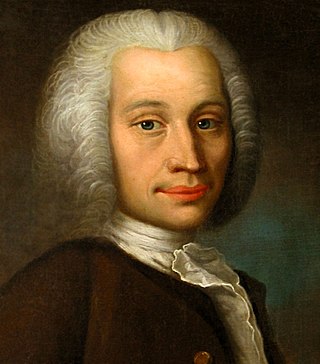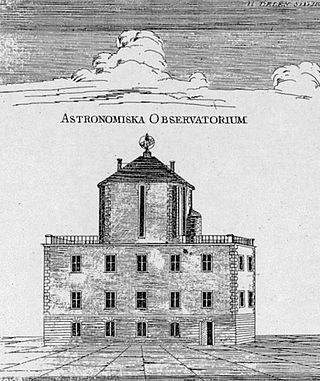Related Research Articles

Anders Celsius was a Swedish astronomer, physicist and mathematician. He was professor of astronomy at Uppsala University from 1730 to 1744, but traveled from 1732 to 1735 visiting notable observatories in Germany, Italy and France. He founded the Uppsala Astronomical Observatory in 1741, and in 1742 proposed the Centigrade temperature scale which was later renamed Celsius in his honour.

Uppsala University (UU) is a public research university in Uppsala, Sweden. Founded in 1477, it is the oldest university in Sweden and the Nordic countries still in operation.

The Uppsala Astronomical Observatory (UAO), Astronomiska observatoriet i Uppsala) is the oldest astronomical observatory in Sweden. It was founded in 1741, though there was a professorial chair of astronomy at the University of Uppsala from 1593 and the university archives include lecture notes in astronomy from the 1480s.
Åke Anders Edvard Wallenquist was a Swedish astronomer. He worked at the Dutch Bosscha Observatory in Indonesia between 1928 and 1935, and became assistant professor at Uppsala's Kvistabergs Observatorium in 1948. He worked originally on double stars but it was the open star clusters and their properties that became his main area of research. Wallenquist was a very active member of both the Royal Swedish Academy of Sciences in Stockholm and the Royal Swedish Society of Sciences in Uppsala. From the 1950s onwards, he was the leading writer of popular astronomy in Sweden among the professional astronomers. His books inspired generations of young people to become interested in astronomy.
Karl Gunnar Malmquist was a Swedish astronomer.

The Kvistaberg Station or Kvistaberg Observatory was a Swedish astronomical observatory and a station of the Uppsala Astronomical Observatory, which both belong to the Department of Physics and Astronomy at Uppsala University. It is located between the Swedish cities of Uppsala and Stockholm, at almost equal distance. Since 2009, the domes and telescopes of the Kvistaberg Observatory are part of a museum.

Estonia sent 27 athletes to the 2006 Winter Olympics in Turin, Italy. Half of them competed in cross-country skiing, where Estonia won all of their three Turin Olympic medals. Olympic champion Andrus Veerpalu participated on his 5th Winter Olympics.

Rainer Kattel is an Estonian academic and science administrator. He is professor of Innovation and Public Governance at Institute for Innovation and Public Purpose, UCL, and Research Professor and Chair of Innovation Policy and Technology Governance at Tallinn University of Technology. In 2015-16, he was a visiting professor at Columbia University's Earth Institute.
Oja may refer to:
2114 Wallenquist, provisional designation 1976 HA, is a Themistian asteroid from the outer region of the asteroid belt, approximately 28 kilometers in diameter. It was discovered by Swedish astronomer Claes-Ingvar Lagerkvist at the Australian Mount Stromlo Observatory near Canberra, on 19 April 1976.

Tarmo Kink is an Estonian former footballer who played as a winger. He works as a coach at Paide Linnameeskond.

Kreisiraadio was an Estonian comedy act, made up of Hannes Võrno, Peeter Oja and Tarmo Leinatamm.
5080 Oja, provisional designation 1976 EB, is a stony Florian asteroid from the inner regions of the asteroid belt, approximately 8 kilometers in diameter. It was discovered on 2 March 1976, by astronomer Claes-Ingvar Lagerkvist at the Kvistaberg Station of the Uppsala Observatory in Sweden. In 1992, it was named after Estonian–Swedish astronomer Tarmo Oja. The S-type asteroid has a rotation period of 7.222 hours.
Tarmo Kikerpill is a retired Estonian professional basketball player. He is 1.96 m in height and he played at the small forward or power forward position.

Tarmo Kõuts is an Estonian politician and former Commander of the Estonian Defence Forces.
Erkki Oja is a Finnish computer scientist and Aalto Distinguished Professor in the Department of Information and Computer Science at Aalto University School of Science. He is recognized for developing Oja's rule, which is a model of how neurons in the brain or in artificial neural networks learn over time.
Tarmo Jallai is a retired Estonian track and field athlete who competed in the 2004 Summer Olympic Games in Athens where he finished in 37th place in the men's 110 metres hurdles event.
Bengt Westerlund was a Swedish astronomer who specialised in observational astronomy.
Kristjan Kõrver is an Estonian composer.

Toomas Urb is an Estonian actor and singer.
References
- ↑ Uppsala University directory: Tarmo Oja, accessed 2010-05-13
- ↑ "5080 Oja (1976 EB)". Minor Planet Center. Retrieved 20 March 2018.